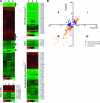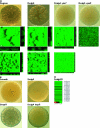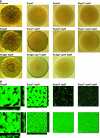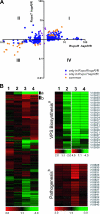Regulation of rugosity and biofilm formation in Vibrio cholerae: comparison of VpsT and VpsR regulons and epistasis analysis of vpsT, vpsR, and hapR
- PMID: 17071756
- PMCID: PMC1797413
- DOI: 10.1128/JB.00981-06
Regulation of rugosity and biofilm formation in Vibrio cholerae: comparison of VpsT and VpsR regulons and epistasis analysis of vpsT, vpsR, and hapR
Abstract
Vibrio cholerae undergoes phenotypic variation that generates two morphologically different variants, termed smooth and rugose. The transcriptional profiles of the two variants differ greatly, and many of the differentially regulated genes are controlled by a complex regulatory circuitry that includes the transcriptional regulators VpsR, VpsT, and HapR. In this study, we identified the VpsT regulon and compared the VpsT and VpsR regulons to elucidate the contribution of each positive regulator to the rugose variant transcriptional profile and associated phenotypes. We have found that although the VpsT and VpsR regulons are very similar, the magnitude of the gene regulation accomplished by each regulator is different. We also determined that cdgA, which encodes a GGDEF domain protein, is partially responsible for the altered vps gene expression between the vpsT and vpsR mutants. Analysis of epistatic relationships among hapR, vpsT, and vpsR with respect to a whole-genome expression profile, colony morphology, and biofilm formation revealed that vpsR is epistatic to hapR and vpsT. Expression of virulence genes was increased in a vpsR hapR double mutant relative to a hapR mutant, suggesting that VpsR negatively regulates virulence gene expression in the hapR mutant. These results show that a complex regulatory interplay among VpsT, VpsR, HapR, and GGDEF/EAL family proteins controls transcription of the genes required for Vibrio polysaccharide and virulence factor production in V. cholerae.
Figures






Similar articles
-
Regulation of Vibrio polysaccharide synthesis and virulence factor production by CdgC, a GGDEF-EAL domain protein, in Vibrio cholerae.J Bacteriol. 2007 Feb;189(3):717-29. doi: 10.1128/JB.00834-06. Epub 2006 Nov 22. J Bacteriol. 2007. PMID: 17122338 Free PMC article.
-
Identification and characterization of VpsR and VpsT binding sites in Vibrio cholerae.J Bacteriol. 2015 Apr;197(7):1221-35. doi: 10.1128/JB.02439-14. Epub 2015 Jan 26. J Bacteriol. 2015. PMID: 25622616 Free PMC article.
-
Cyclic-diGMP signal transduction systems in Vibrio cholerae: modulation of rugosity and biofilm formation.Mol Microbiol. 2006 Apr;60(2):331-48. doi: 10.1111/j.1365-2958.2006.05106.x. Mol Microbiol. 2006. PMID: 16573684
-
Expression of Vibrio cholerae virulence genes in response to environmental signals.Curr Issues Intest Microbiol. 2002 Sep;3(2):29-38. Curr Issues Intest Microbiol. 2002. PMID: 12400636 Review.
-
[The current status of the problem of Vibrio cholerae variability].Zh Mikrobiol Epidemiol Immunobiol. 1999 Jul-Aug;(4):103-6. Zh Mikrobiol Epidemiol Immunobiol. 1999. PMID: 10852073 Review. Russian. No abstract available.
Cited by
-
A semi-quantitative approach to assess biofilm formation using wrinkled colony development.J Vis Exp. 2012 Jun 7;(64):e4035. doi: 10.3791/4035. J Vis Exp. 2012. PMID: 22710417 Free PMC article.
-
Regulation of flagellar motility during biofilm formation.FEMS Microbiol Rev. 2013 Nov;37(6):849-71. doi: 10.1111/1574-6976.12018. Epub 2013 Apr 12. FEMS Microbiol Rev. 2013. PMID: 23480406 Free PMC article. Review.
-
Roles of the second messenger c-di-GMP in bacteria: Focusing on the topics of flagellar regulation and Vibrio spp.Genes Cells. 2022 Mar;27(3):157-172. doi: 10.1111/gtc.12921. Epub 2022 Jan 24. Genes Cells. 2022. PMID: 35073606 Free PMC article. Review.
-
Interplay among cyclic diguanylate, HapR, and the general stress response regulator (RpoS) in the regulation of Vibrio cholerae hemagglutinin/protease.J Bacteriol. 2011 Dec;193(23):6529-38. doi: 10.1128/JB.05166-11. Epub 2011 Sep 30. J Bacteriol. 2011. PMID: 21965573 Free PMC article.
-
Interplay between cyclic AMP-cyclic AMP receptor protein and cyclic di-GMP signaling in Vibrio cholerae biofilm formation.J Bacteriol. 2008 Oct;190(20):6646-59. doi: 10.1128/JB.00466-08. Epub 2008 Aug 15. J Bacteriol. 2008. PMID: 18708497 Free PMC article.
References
-
- Ali, A., J. A. Johnson, A. A. Franco, D. J. Metzger, T. D. Connell, J. G. Morris, Jr., and S. Sozhamannan. 2000. Mutations in the extracellular protein secretion pathway genes (eps) interfere with rugose polysaccharide production in and motility of Vibrio cholerae. Infect. Immun. 68:1967-1974. - PMC - PubMed
-
- Bao, Y., D. P. Lies, H. Fu, and G. P. Roberts. 1991. An improved Tn7-based system for the single-copy insertion of cloned genes into chromosomes of gram-negative bacteria. Gene 109:167-168. - PubMed
-
- Carroll, P. A., K. T. Tashima, M. B. Rogers, V. J. DiRita, and S. B. Calderwood. 1997. Phase variation in tcpH modulates expression of the ToxR regulon in Vibrio cholerae. Mol. Microbiol. 25:1099-1111. - PubMed
Publication types
MeSH terms
Substances
Grants and funding
LinkOut - more resources
Full Text Sources
Molecular Biology Databases

